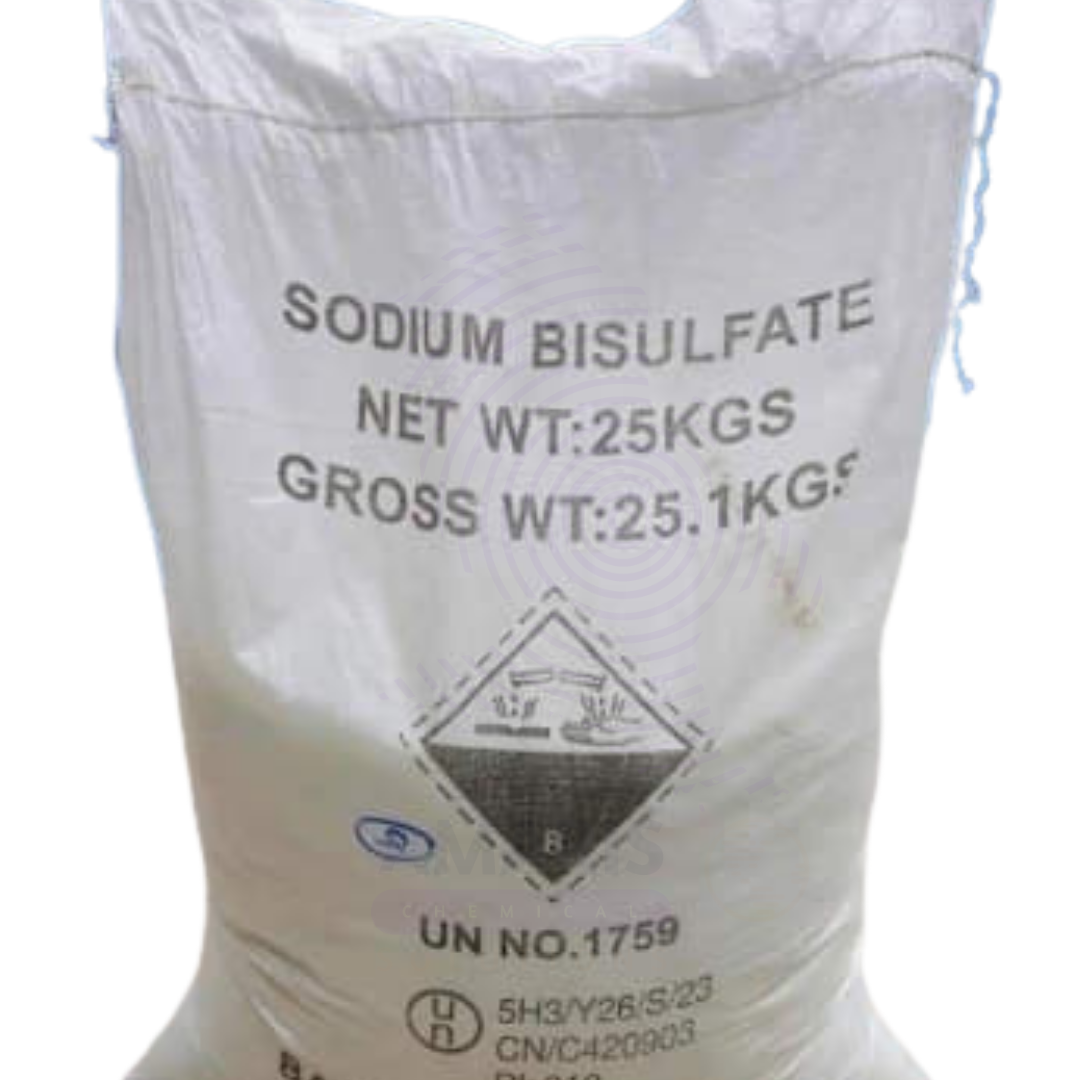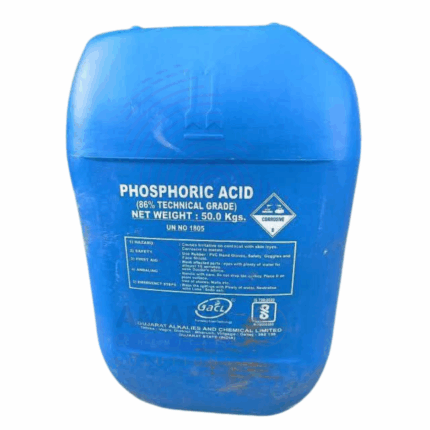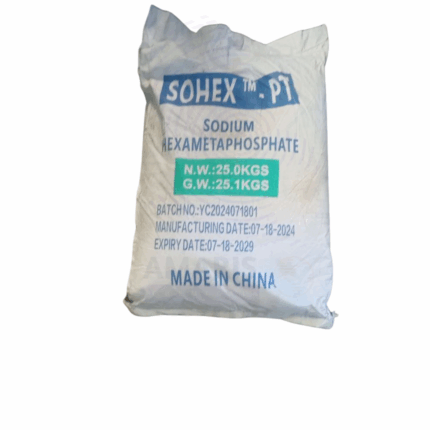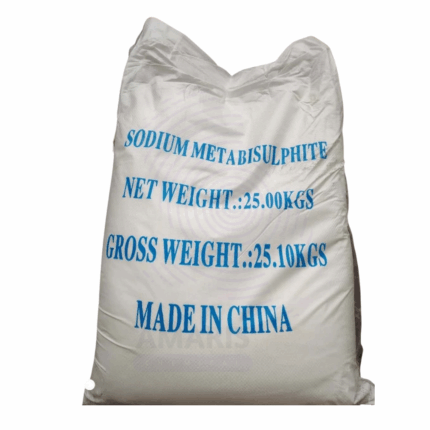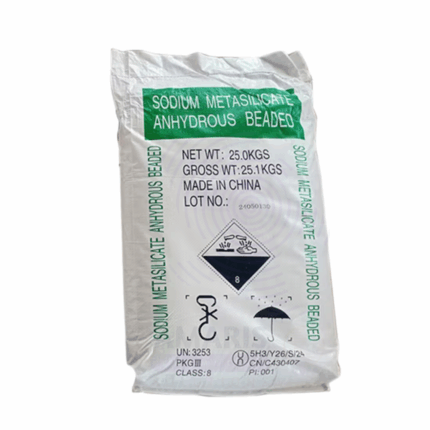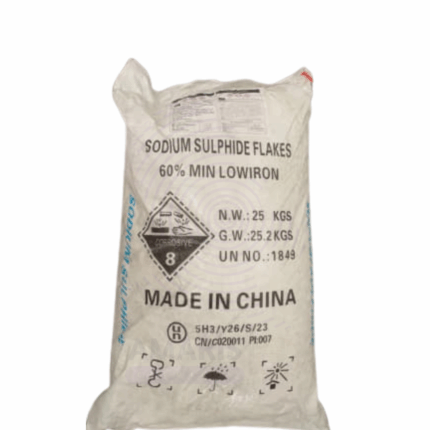
Sodium Bisulphate Monohydrate
Sodium Bisulphate Monohydrate, also known as sodium hydrogen sulphate, is a white crystalline powder or granular solid commonly used as an acidic cleaning agent, pH adjuster, and bleaching accelerator. It is a dry acid that releases sulfur dioxide when dissolved in water, making it effective in various industrial, food, and water treatment applications. This compound is valued for its ability to lower pH safely and is widely used where a controlled acidification is required without handling hazardous liquid acids.
Sodium Bisulphate Monohydrate
Primary Uses
- Water Treatment
- Used to lower pH in swimming pools, cooling towers, and industrial water systems to prevent scaling and corrosion.
- Acts as a disinfectant booster by creating acidic conditions that improve sanitizer efficiency.
- Cleaning Industry
- Employed as a descaling and cleaning agent for removing mineral deposits, rust, and stains from metal surfaces and equipment.
- Used in household cleaning products, especially in toilet bowl cleaners and bathroom cleaners, due to its acidic nature.
- Food & Beverage Industry
- Used as an acidulant and pH control agent in food processing, especially in baking powders and certain beverages.
- Serves as a leavening acid in combination with sodium bicarbonate in baking applications.
- Industrial Applications
- Utilized in textile and leather processing for pH adjustment.
- Acts as a bleaching accelerator in detergent formulations.
Secondary Uses
- Cosmetics and Personal Care
- Incorporated in certain cosmetic formulations to adjust acidity and preserve product stability.
- Agriculture
- Used to acidify soil in controlled applications, promoting nutrient availability for certain crops.
- Laboratory & Analytical Uses
- Employed as a reagent for acidification in chemical analyses.
Basic Identification Attributes
- Chemical Name (IUPAC): Sodium bisulfate (Sodium hydrogen sulfate)
- Common/Trade Name: Sodium Bisulphate
- CAS Number: 7681-38-1
- HS Code: 2833.29
- Synonyms: Sodium hydrogen sulfate, dry acid, sodium bisulfate
Physical & Chemical Properties
- Physical State: Solid powder or granules
- Color & Odor: White, odorless
- Solubility: Soluble in water, releasing acidic solutions
- pH: Approximately 1–2 in aqueous solution (acidic)
- Density: Approx. 2.66 g/cm³
Safety & Hazard Attributes
- GHS Classification: Corrosive to skin and eyes
- Toxicity: Moderate; can cause burns on contact
- Exposure Limits: Use with adequate ventilation; avoid inhalation and contact
Storage & Handling Attributes
- Storage Conditions: Store in a cool, dry, well-ventilated area away from moisture and incompatible substances such as alkalis
- Container Type: Bags or sealed drums
- Shelf Life: Typically 1–2 years when stored properly
- Handling Precautions: Use protective gloves, goggles, and clothing; avoid dust inhalation
Regulatory & Compliance Attributes
- Complies with industrial chemical safety standards (e.g., REACH, OSHA)
- Approved for food additive use in regulated quantities (where applicable)
- Meets environmental regulations for handling acidic chemicals
Environmental & Health Impact
- Biodegradability: Inorganic compound; does not biodegrade but is environmentally stable
- Ecotoxicity: Can be harmful in large quantities due to acidity
Bioaccumulation: Not significant
Safety Handling Precautions
- PPE Required: Acid-resistant gloves, eye protection, protective clothing, and dust masks recommended
- Handling Guidelines: Use in well-ventilated areas; avoid skin and eye contact; prevent dust formation
- Storage Measures: Keep containers tightly closed and stored in a dry environment
First Aid Measures
- Inhalation: Move to fresh air immediately; seek medical attention if respiratory irritation develops
- Skin Contact: Rinse immediately with plenty of water; seek medical help if burns or irritation persist
- Eye Contact: Flush eyes with water for at least 15 minutes; get urgent medical attention
- Ingestion: Rinse mouth with water; do not induce vomiting; seek immediate medical assistance
Firefighting Measures
- Fire Hazards: Non-flammable but can release sulfur dioxide upon decomposition
- Extinguishing Media: Use water spray, foam, dry chemical, or CO₂ for surrounding fires
- Special Precautions: Use protective equipment and self-contained breathing apparatus when fighting fires
- Hazardous Combustion Products: Sulfur oxides (SOx)


 Preservatives(food)
Preservatives(food) Flavor Enhancers
Flavor Enhancers Acidulants
Acidulants Sweeteners
Sweeteners Antioxidants
Antioxidants Colorants(food)
Colorants(food) Nutraceutical Ingredients (food)
Nutraceutical Ingredients (food) Nutrient Supplements
Nutrient Supplements Emulsifiers
Emulsifiers
 Collectors
Collectors Dust Suppressants
Dust Suppressants Explosives and Blasting Agents
Explosives and Blasting Agents Flocculants and Coagulants
Flocculants and Coagulants Frothers
Frothers Leaching Agents
Leaching Agents pH Modifiers
pH Modifiers Precious Metal Extraction Agents
Precious Metal Extraction Agents
 Antioxidants(plastic)
Antioxidants(plastic) Colorants (Pigments, Dyes)
Colorants (Pigments, Dyes) Fillers and Reinforcements
Fillers and Reinforcements Flame Retardants
Flame Retardants Monomers
Monomers Plasticizers
Plasticizers Polymerization Initiators
Polymerization Initiators Stabilizers (UV, Heat)
Stabilizers (UV, Heat)
 Antifoaming Agents
Antifoaming Agents Chelating Agents
Chelating Agents Coagulants and Flocculants
Coagulants and Flocculants Corrosion Inhibitors
Corrosion Inhibitors Disinfectants and Biocides
Disinfectants and Biocides Oxidizing Agents
Oxidizing Agents pH Adjusters
pH Adjusters Scale Inhibitors( water)
Scale Inhibitors( water)
 Antioxidants(cosmetic)
Antioxidants(cosmetic) Emollients
Emollients Fragrances and Essential Oils
Fragrances and Essential Oils Humectants
Humectants Preservatives
Preservatives Surfactants(cosmetic)
Surfactants(cosmetic) Thickeners
Thickeners UV Filters
UV Filters
 Fertilizers
Fertilizers Soil Conditioners
Soil Conditioners Plant Growth Regulators
Plant Growth Regulators Animal Feed Additives
Animal Feed Additives Biostimulants
Biostimulants Pesticides (Herbicides, Insecticides, Fungicides)
Pesticides (Herbicides, Insecticides, Fungicides)
 Active Pharmaceutical Ingredients (APIs)
Active Pharmaceutical Ingredients (APIs) Excipients
Excipients Solvents(pharmaceutical)
Solvents(pharmaceutical) Antibiotics
Antibiotics Antiseptics and Disinfectants
Antiseptics and Disinfectants Vaccine Adjuvants
Vaccine Adjuvants Nutraceutical Ingredients (pharmaceutical)
Nutraceutical Ingredients (pharmaceutical) Analgesics & Antipyretics
Analgesics & Antipyretics
 Analytical Reagents
Analytical Reagents Solvents(lab)
Solvents(lab) Chromatography Chemicals
Chromatography Chemicals Spectroscopy Reagents
Spectroscopy Reagents microbiology-and-cell-culture-reagents
microbiology-and-cell-culture-reagents Molecular Biology Reagents
Molecular Biology Reagents Biochemical Reagents
Biochemical Reagents Inorganic and Organic Standards
Inorganic and Organic Standards Laboratory Safety Chemicals
Laboratory Safety Chemicals Specialty Laboratory Chemicals(Special Laboratory Equipment)
Specialty Laboratory Chemicals(Special Laboratory Equipment)
 Demulsifiers
Demulsifiers Hydraulic Fracturing Fluids
Hydraulic Fracturing Fluids Scale Inhibitors(oil)
Scale Inhibitors(oil) Surfactants(oil)
Surfactants(oil) Drilling Fluids
Drilling Fluids
 Dyes and Pigments
Dyes and Pigments Bleaching Agents
Bleaching Agents Softening Agents
Softening Agents Finishing Agents
Finishing Agents Antistatic Agents
Antistatic Agents
 Admixtures
Admixtures Waterproofing Agents
Waterproofing Agents Sealants and Adhesives
Sealants and Adhesives Curing Compounds
Curing Compounds Concrete Repair Chemicals
Concrete Repair Chemicals Anti-Corrosion Coatings
Anti-Corrosion Coatings
 Surfactants(cleaning)
Surfactants(cleaning) Builders
Builders Enzymes
Enzymes Solvents (Cleaning)
Solvents (Cleaning) Fragrances
Fragrances
 Electronic Chemicals
Electronic Chemicals Catalysts
Catalysts Lubricants
Lubricants Photographic Chemicals
Photographic Chemicals Refrigerants
Refrigerants Automotive chemicals
Automotive chemicals Pyrotechnic Chemicals
Pyrotechnic Chemicals
 Biodegradable Surfactants
Biodegradable Surfactants Bio-based Solvents
Bio-based Solvents Renewable Polymers
Renewable Polymers Carbon Capture Chemicals
Carbon Capture Chemicals Wastewater Treatment Chemicals
Wastewater Treatment Chemicals
 Pigments
Pigments Solvents(paint)
Solvents(paint) Specialty Coatings
Specialty Coatings Binders/Resins
Binders/Resins Additives
Additives Driers
Driers Anti-Corrosion Agents
Anti-Corrosion Agents Functional Coatings
Functional Coatings Application-Specific Coatings
Application-Specific Coatings
 Fresh Herbs
Fresh Herbs Ground Spices
Ground Spices Whole Spices
Whole Spices Spice Blends
Spice Blends Dried Herbs
Dried Herbs
 Leavening Agents
Leavening Agents Dough Conditioners
Dough Conditioners Flour Treatments
Flour Treatments Fat Replacers
Fat Replacers Decoratives
Decoratives Preservatives(baking)
Preservatives(baking)
 Plasticizers & Softeners
Plasticizers & Softeners Reinforcing Agents
Reinforcing Agents Adhesion Promoters
Adhesion Promoters Vulcanizing Agents
Vulcanizing Agents Antidegradants
Antidegradants Blowing Agents
Blowing Agents Fillers & Extenders
Fillers & Extenders Accelerators & Retarders
Accelerators & Retarders